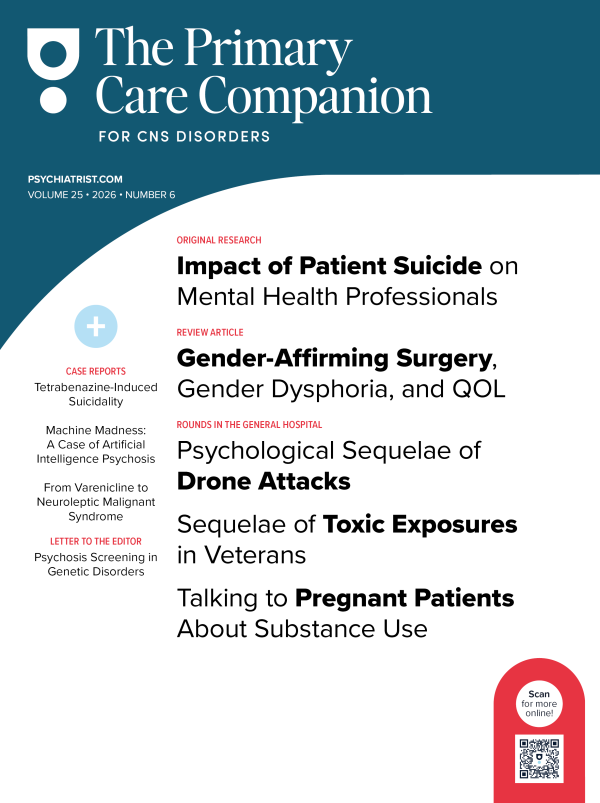Ondansetron-Induced Myoclonus With Escitalopram and Highly Active Antiretroviral Therapy: A Closer Look at 5-HT3 Receptors
To the Editor: Kolli and Addula1 reported an interesting case of possible serotonin syndrome as a pharmacokinetic interaction of ondansetron, escitalopram, and highly active antiretroviral therapy.
In September 2014, the US Food and Drug Administration changed the safety labeling for 5-HT3 receptor antagonists—ondansetron, granisetron, palonosetron, and dolasetron. The new warning suggests advising patients of the possible development of serotonin syndrome with use of the 5-HT3 receptor antagonists and agents used to treat depression and migraines.2 It is known that 5-HT3 stimulation (eg, by selective serotonin reuptake inhibitors [SSRIs] increasing the availability of serotonin in the synaptic cleft to stimulate these postsynaptic receptors) accounts for the side effects of headache, nausea, and vomiting.
The recent introduction of the multimodal agent vortioxetine has provided more insight into the functions of 5-HT3 receptors. It has been demonstrated that when the 5-HT level increases after administration of an SSRI, activation of the ligand-gated ionic 5-HT3 receptors by 5-HT leads to stimulation of γ-aminobutyric acid (GABA) release. This release then inhibits cortical pyramidal neurons, and, thus, there is no amplification of 5-HT release by downstream glutamate.3 Hence, blockade of 5-HT3 receptors removes GABA inhibition and disinhibits pyramidal neurons, enhancing downstream release of 5-HT due to glutamatergic stimulation of serotonergic neurons in the midbrain raphe.3 This pharmacologic receptor portfolio implies that agents with 5-HT3 antagonism (eg, ondansetron) can, in theory, contribute to the development of serotonin syndrome through pharmacodynamic mechanisms as well. Serotonin syndrome is more likely to develop if agents with 5-HT3 antagonism are combined with other serotonergic agents or in the setting of overdose.4 Such cases are documented in the literature.5 On the other hand, these 5-HT3-blocking agents have been used to boost 5-HT tone in conditions such as treatment-resistant obsessive-compulsive disorder.6
References
1.Kolli V, Addula M. Ondansetron-induced myoclonus with escitalopram and HAART: role of drug interactions. Prim Care Companion CNS Disord. 2019;21(4):18l02364. PubMed CrossRef
2.Foong A-L, Grindrod KA, Patel T, et al. Demystifying serotonin syndrome (or serotonin toxicity). Can Fam Physician. 2018;64(10): 720-727. PubMed CrossRef
3.Naguy A, Alamiri B. Successful add-on vortioxetine for an adolescent with attention-deficit/hyperactivity disorder. J Clin Psychopharmacol. 2018;38(4):407-409. PubMed CrossRef
4.Naguy A. SSRIs-related behavioral syndromes in children and adolescents. J Can Acad Child Adolesc Psychiatry. 2016;25(2):69-70. PubMed
5.Gollapudy S, Kumar V, Dhamee MS. A case of serotonin syndrome precipitated by fentanyl and ondansetron in a patient receiving paroxetine, duloxetine, and bupropion. J Clin Anesth. 2012;24(3):251-252. PubMed CrossRef
6.Naguy A, Alamiri B. Treatment-resistant OCD—a psychopharmacological ‘ touche d’ art.’ Asian J Psychiatr. 2018;34:98-99. PubMed CrossRef
aAl-Manara CAP Centre, Kuwait Centre for Mental Health, Jamal Abdul-Nassir St, Shuwaikh, State of Kuwait
Published online: June 18, 2020.
Potential conflicts of interest: None.
Funding/support: None.
Prim Care Companion CNS Disord 2020;22(3):19l02524
To cite: Naguy A. Ondansetron-induced myoclonus with escitalopram and highly active antiretroviral therapy: a closer look at 5-HT3 receptors. Prim Care Companion CNS Disord. 2020;22(3):19l02524.
To share: https://doi.org/10.4088/PCC.19l02524
© Copyright 2020 Physicians Postgraduate Press, Inc.
Please sign in or purchase this PDF for $40.00.


